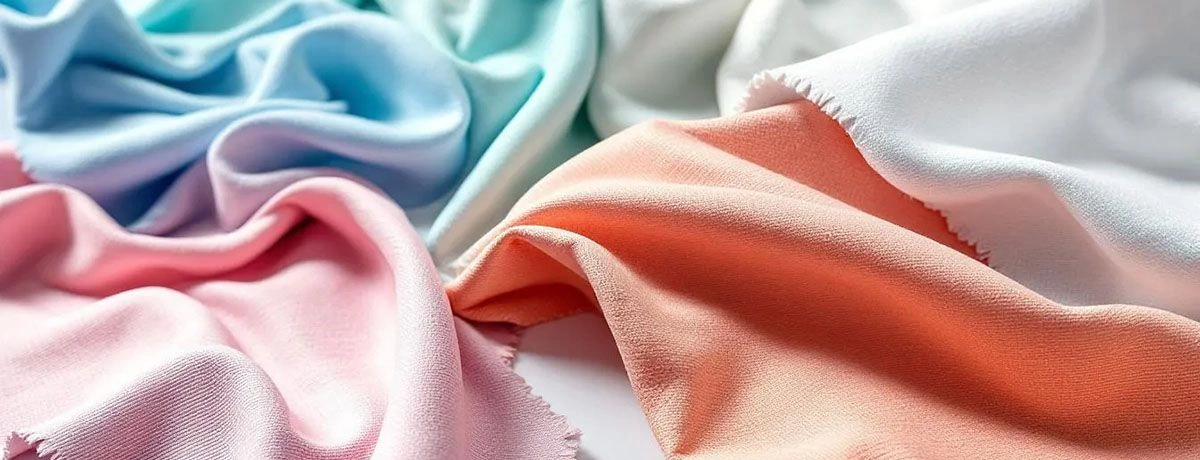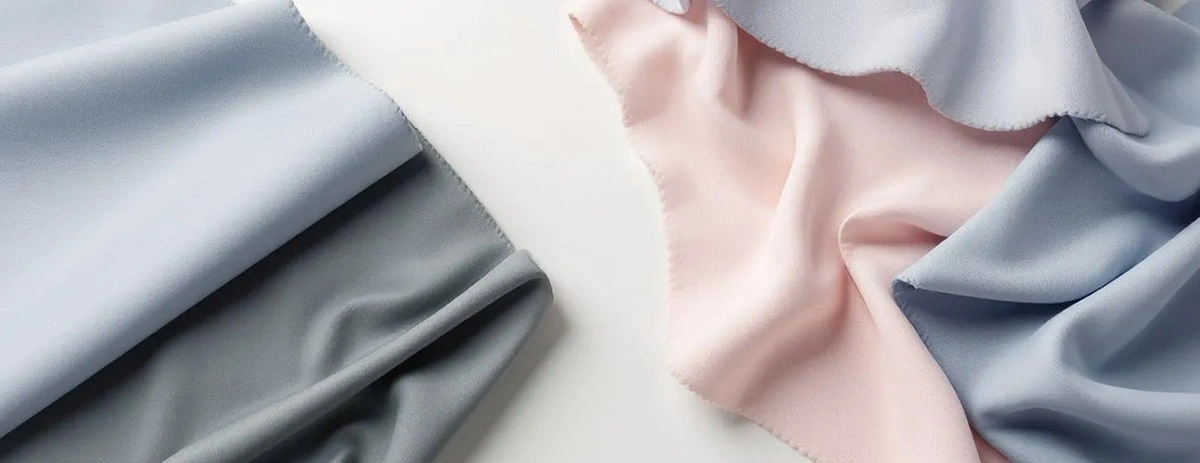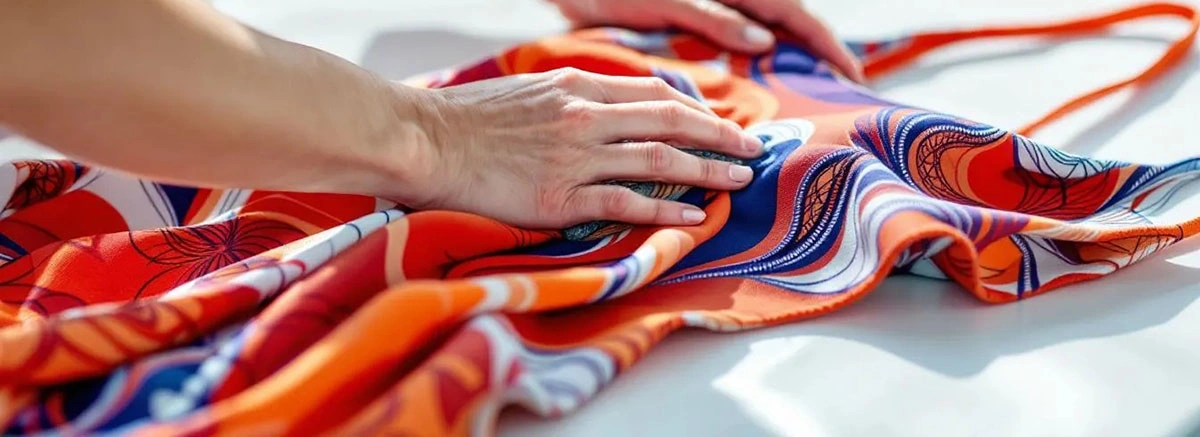Materials for Swimsuits: Essential Fabrics You Need to Know

When choosing materials for swimsuits, it’s essential to know which fabrics offer the best comfort, flexibility, and durability. This article dives into the most popular swimsuit fabrics, their performance features, and how to choose the right one for your needs.
Key Takeaways
-
Nylon and polyester spandex blends are the top choices for swimwear due to their excellent stretch, comfort, and durability.
-
Recycled materials in swimwear are trending, contributing to sustainability while maintaining strong performance features.
-
Proper care and maintenance of swimsuit fabrics are essential for longevity, including washing in cold water and avoiding harsh drying methods.
Key Swimsuit Fabrics

Different types of swimwear fabrics can greatly enhance your swimwear experience. Whether you prefer the elasticity of nylon spandex blends or the durability of polyester spandex blends, knowing the fabric content helps make an informed decision. These fabrics, often blended with spandex, offer an excellent balance of stretch, shape retention, and comfort.
Nylon spandex blends and polyester spandex blends are top choices for swimwear due to their superior elasticity and comfort. Their excellent stretch and recovery make them suitable for both casual beach days and competitive swimming.
The use of recycled materials in swimwear is a growing trend, combining eco-friendliness with excellent performance features.
Nylon Spandex Blends
Nylon spandex blends typically consist of around 80% nylon and 20% spandex, providing excellent elasticity and flexibility for movement. This combination makes them incredibly comfortable for swimmers, as they offer a soft, glossy sheen that feels luxurious against the skin.
Spandex in nylon blends ensures the fabric maintains its shape and provides a perfect body fit during aquatic activities. This combination is popular in the swimwear industry for its aesthetic appeal and functional benefits.
Polyester Spandex Blends
Polyester spandex blends are a favorite in competitive swimwear due to:
-
Their strength and resistance to chlorine.
-
Typically containing 15–25% spandex mixed with polyester, enhancing stretch and fit.
-
The durability and quick-drying characteristics of polyester, making it excellent for those who spend a lot of time in the water.
Polyester swimwear fabrics are valued for their UV protection and colorfast properties, ensuring long-lasting vibrancy and resistance to fading. This durability makes them ideal for both competitive swimming and casual beach outings, retaining shape and color even after repeated use. The use of polyester fabric enhances these qualities.
Recycled Materials
The swimwear industry is increasingly incorporating eco-friendly materials, signaling a shift towards sustainability in fashion. Recycled swimwear fabrics, such as ECONYL®, REPREVE®, and regenerated nylon, are made from recycled plastic bottles and discarded fishing nets, helping to reduce environmental impact.
Recycled materials help remove plastic from landfills and oceans and require less energy and water to produce. These recycled fabrics and other fabrics offer durability and flexibility, making them an excellent choice for those seeking the right material for environmentally conscious options without compromising performance. Industrial plastic can also play a role in this sustainable approach.
Performance Features of Swimwear Fabrics
Swimwear performance is heavily influenced by the fabric’s resistance to environmental factors like chlorine, UV rays, and saltwater. These performance features are crucial in maintaining the durability and comfort of swimwear over time. Key attributes like stretch and recovery, UV protection, and quick-drying properties are essential for ensuring a comfortable and long-lasting swimwear experience.
Understanding these features helps make informed decisions when choosing swimsuit fabrics, ensuring your swimwear meets your specific needs and preferences. Here are the essential performance features that make swimwear fabrics stand out.
Stretch and Recovery
Stretch and recovery ensure a perfect body fit during aquatic activities. Four-way stretch fabric, which stretches both lengthwise and crosswise, enhances mobility during swimming, making it ideal for athletic swimwear with a soft stretch and natural stretch.
Scuba fabric, known for its unique combination of stretch and structure, offers both aesthetic appeal and functionality in swimwear designs. Fabrics with a flexibility percentage of 60-70% are recommended for athletic swimwear, as they provide the necessary support while allowing for free movement.
UV Protection
UV protection is crucial in swimwear fabrics, especially for those who spend extended periods in the sun. Key points about UPF-rated fabrics include:
-
They are designed to block harmful UV rays.
-
A UPF 50+ rating means only 1/50th of UV radiation can penetrate the fabric.
-
This level of excellent uv protection and uv resistance helps prevent skin damage and provides optimal sun protection.
Polyester swimwear fabrics are recommended for their built-in UV protection and ability to tolerate chlorine exposure. These fabrics maintain their UV protection even after repeated washing, making them a durable and reliable choice for swimwear.
Quick-Drying and Breathability
Quick-drying and breathable fabrics that repels water prevent the discomfort of wet swimwear after exiting the water. Synthetic fibers like polyester and PBT ensure rapid drying and maintain comfort.
Modern moisture-wicking treatments enhance the quick-dry properties of swimwear, while tight weave construction prevents water absorption, reducing drying time. These features make synthetic fabrics an excellent choice for swimwear, offering both comfort and performance.
Choosing the Right Swimsuit Material
Choosing the right swimsuit material involves understanding the specific needs and preferences of the wearer. Commonly used swimsuit fabrics include stretchy synthetic materials that are chlorine and UV resistant, typically polyester or nylon blended with elastane. These fabrics should highlight assets, fit well, boost confidence, enhance performance, and serve as the ideal material for swimwear fabric. Choosing swimsuit material is essential for achieving the best results.
Choosing durable and easy-to-maintain fabrics ensures the longevity of your swimwear, making it a worthwhile investment. Here are the best fabrics for swimsuit fabrics and the best fabric for different types of swimmers: recreational, competitive, and family activities.
Recreational Swimming
For casual swimmers, comfort and durability are paramount. Nylon-spandex blends, commonly used in women’s swimwear, offer softness and stretch. These blends provide the ideal combination of elasticity and comfort, perfect for lounging by the pool or enjoying a leisurely swim.
Heavier fabrics are preferred for tanning or lounging outside the water, offering added comfort. For recreational swimwear, a maximum of 20 to 25% spandex content is recommended to ensure durability without excessive stretch.
Competitive Swimming
Competitive swimmers need high-performance fabrics that:
-
Enhance speed and reduce drag
-
Are lightweight and compressive to streamline the swimmer’s body in the water
-
Are often polyester blends with elastane
-
Support durability and optimal performance
Compression and lightweight properties are crucial for competitive swimwear, enabling swimmers to move faster and perform better. These fabrics are designed to withstand intense swimming sessions, providing reliable performance.
Family Activities
For family activities, especially children’s swimwear, nylon-spandex blends are recommended for their softness and flexibility. Bright colors and bold patterns in synthetic fabrics help maintain visibility, ensuring children’s safety in the water.
These different fabrics offer the perfect fabric balance of comfort, durability, and visibility for the best swimsuits swim shorts bathing suit jl bristol fabric for swimwear.
Caring for Your Swimsuit Fabrics

Proper care and maintenance extend the lifespan of your swimsuit fabrics. Each material requires specific maintenance to preserve its protective properties against chlorine, heat, body oils, saltwater, and UV rays. Proper fabric care influences the durability and performance of swimwear, making it a worthwhile investment.
Rinsing swimsuits immediately after swimming removes chlorine, salt, and other contaminants that can degrade the fabric and affect its chlorine resistance. Avoid contact with rough surfaces to prevent damage during storage.
Let’s delve into specific washing, drying, and storage tips to keep your swimwear in top condition.
Washing and Drying
To properly care for swimsuits:
-
Always wash them in cold water to maintain fabric integrity.
-
Separate them from rough fabrics when washing to avoid damage.
-
Use a pH-neutral detergent designed for delicate fabrics to help maintain elasticity.
When washing swimsuits, follow these guidelines:
-
For machine washing, place swimsuits in a mesh laundry bag to avoid snagging.
-
For nylon swimwear, wash gently by hand in cool water with mild detergent.
-
For polyester swimwear, use cold water, set your machine to a gentle cycle, and add mild soap.
To dry swimwear, lay it flat on a towel to absorb water instead of wringing it out. Avoid using dryers and direct sunlight to prevent fabric damage.
Storage and Maintenance
For optimal storage, keep swimsuits lay flat in a cool, dry location away from sunlight. Avoid hanging swimsuits on hangers to prevent fabric stretching.
Proper storage prevents damage and extends the lifespan of your swimsuits.
Trends in Swimwear Fabrics
The swimwear industry continually evolves, with new trends in fabrics and designs emerging regularly. Manufacturers offer diverse color and texture options, meeting the demand for personalized swimwear. Trends focus on innovative designs and textures to enhance visual appeal and functionality.
From smooth to ribbed textures, modern textures and innovative designs continue to shape the swimwear market. Here are some of the latest trends in swimwear fabrics making waves this season.
Ribbed Textures
Ribbed fabrics are gaining popularity in modern swimwear for their stylish appearance and functional benefits. Combining nylon with other materials in ribbed swim fabrics enhances comfort and support.
Ribbed textures provide a slimming appearance while adding depth to the design, making them an excellent choice for fashionable swimwear with a ribbed texture.
Velvet and Other Luxurious Fabrics
Velvet swimwear is creating a niche market that emphasizes luxury and unique styling. The texture and feel of velvet fabric are soft with a characteristic pile and fur-like touch, making it an opulent and visually appealing choice for swimwear.
However, velvet fabric in swimwear has some drawbacks, such as flattening when wet and requiring special washing. Despite these challenges, the luxurious look and feel of velvet swimwear make it a popular choice for those looking to make a statement at the pool or beach.
Wholesale Order
If you’re looking to start a swimwear line or need fabrics in bulk, MH is a professional wholesale supplier of garment accessories and fabrics from China. MH focuses on wholesale only, not retail, and is known for its reliability, consistent quality, and long-term partnerships in the global market.
Ordering wholesale fabrics from MH provides numerous benefits, including factory-direct pricing, stable quality assurance, and a wide range of major fabric options for customization.
With over 25 years of experience in textile manufacturing and export, MH offers high-performance stretch materials that are perfect for swimwear, activewear, and sportswear.
Summary
Understanding the various swimwear fabrics is essential for making informed choices that suit your specific needs. From the elasticity of nylon spandex blends to the durability of polyester spandex blends, and the eco-friendliness of recycled materials, each type of fabric offers unique benefits. Performance features like stretch and recovery, UV protection, and quick-drying properties further enhance the functionality and comfort of swimwear.
By following proper care and maintenance practices, you can extend the lifespan of your swimwear, ensuring it remains vibrant and durable. Additionally, staying updated with the latest trends, such as ribbed textures and luxurious fabrics like velvet, can help you stay stylish and comfortable. Whether you’re a casual swimmer, a competitive athlete, or a parent looking for the best swimwear for your family, this guide provides the insights needed to choose the right swimsuit fabric.
Frequently Asked Questions
What are the best fabrics for swimwear?
For swimwear, you can't go wrong with nylon spandex or polyester spandex blends; they offer great elasticity, comfort, and durability. So, if you're gearing up for a swim, these fabrics are definitely the way to go!
Why is UV protection important in swimwear fabrics?
UV protection in swimwear fabrics is essential because it helps shield your skin from harmful UV rays, reducing the risk of sunburn and long-term skin damage. Choosing UPF-rated swimwear ensures you get effective protection while enjoying the sun.
How can I care for my swimwear to extend its lifespan?
To extend the lifespan of your swimwear, wash it in cold water with a pH-neutral detergent, avoid rough surfaces, and dry it flat away from direct sunlight. Taking these steps will keep your swimsuit looking great for longer!
What are some trendy materials in swimwear fabrics?
Ribbed textures and luxurious velvet are definitely trendy in swimwear right now, giving you that perfect blend of style and functionality. Choose these fabrics to elevate your beach look!
What are the benefits of using recycled materials in swimwear?
Using recycled materials in swimwear helps reduce environmental impact by repurposing waste and minimizing energy and water consumption, making your swimwear choices more eco-friendly. It's a simple way to be stylish while caring for the planet!


